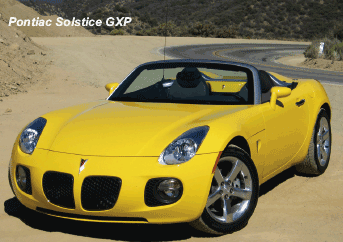|
This is just great. If you love small convertible sports cars like I do, you’re also picky about “the look.” You’ll ogle it from every angle, crouch down and look again, and then… well, you know how it goes. The sports car is such a personal statement that it’s got to look just right!
GM has done a smart thing here. With the Sky and Solstice, you get a choice of two stunning but very different body and interior designs. And with either, you have two engine choices and also two transmissions—5-speed stick or 5-speed auto.
Pontiac’s Solstice has sensuously rounded curves that hint of ’60s European sports cars such as Jags and Ferraris. Simple and elegant. Saturn’s Sky on the other hand was penned with styling that is busier, more sharp-edged, more modern.
 The differences continue inside, with the Sky receiving greater design effort. The Sky is positioned as the slightly more upscale version of the two, and it shows in the interior design details and materials. The differences continue inside, with the Sky receiving greater design effort. The Sky is positioned as the slightly more upscale version of the two, and it shows in the interior design details and materials.
Base engine on both cars is a 2.4L dual-overhead cam 4-cylinder unit with 177 horsepower. It is quick enough to satisfy, scooting from 0–60 in the low-to mid-seven second range.
In a hurry? Order the turbocharged engine that both my testers came with. This 2.0L dual-overhead cam 4-cylin-der features direct injection for better fuel economy. It also packs 260 horsepower for scorching 0–60 times in the low- to mid-five second range. Better fuel economy and 83 more horsepower? Sign me up!
With direct injection, the fuel injectors are positioned at the top of each cylinder so fuel is injected directly into the combustion chamber, hence “direct injection.”
When I took my friend Kelvin for a ride in the Sky Redline, he asked “What would you change?” Excellent question. There are four improvements I’d like to see. The soft top is fussy to lower and raise. You have to get out of the car to do either. Next, trunk space is miniscule. Even with the top up, it won’t hold a small suitcase because the gas tank intrudes. Third, the driver’s seat desperately needs a height adjuster. Finally, I’d gladly see these cars lengthened by a few inches if those inches meant more legroom.
The foregoing niggles vanish, though, as soon as you reach your favorite winding road. Simply put, these cars are HUGE fun to drive when traffic thins out and you’re corner carving top down through the canyons. Steering is sharp and responsive without being twitchy. Wide tires offer considerable grip, and squeal nicely as a warning when you’ve reached their limits of traction. The traction control works well; you can feel it cut in when you’ve stuffed yourself into a  corner too quickly. It helps you keep your intended line whether you suffer from inexperience or indiscretion. On the right roads, these are among the most entertaining cars you can find anywhere. corner too quickly. It helps you keep your intended line whether you suffer from inexperience or indiscretion. On the right roads, these are among the most entertaining cars you can find anywhere.
Sans turbo, prices range from around $20,000 to $25,000. With turbo, pricing runs into the $28,000 to $32,000 range. These two with automatic are EPA-rated at 19-city, 26-highway mpg. I averaged about 22 mpg. On one tank for an all day trip in the mountains, I averaged 27 mpg by restraining my right foot.
These are beautifully styled, fun cars to drive. While impractical for an only car, they make great second cars for those who love to drive. Mike Cooney is a lifelong auto enthusiast living and writing in Southern California. Comments are welcome at Michael@GlobalBrand.com.

|